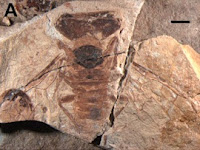Bethylid Wasps are a diverse group of Chrysid (Stinging) Wasps, found across the world today, but most abundant in the tropics. They are predominantly parasitoids, laying their eggs on Beetles, Butterflies, Moths or sometimes other Wasps, which they sting and bury alive for their larvae to consume from within, though some species are hunters, bringing a succession of prey animals to feed their young. Bethylids are thought to have been among the first Chrysids, making their origins important to our understanding of the group. However, while the Tertiary history of the group is well documented, relatively few Mesozoic species have been described, and those that have (and a number of undescribed Cretaceous Bethylids from France and New Jersey) appear to be relatively advanced members of the group.
In a paper published in the American Museum Novitates on 7 April 2017, Michael Engel of the Division of Invertebrate Zoology (Entomology) at the American Museum of Natural History, the Division of Entomology (Paleoentomology) at the Natural History Museum and the Department of Ecology and Evolutionary Biology at the University of Kansas, Jaime Ortega-Blanco, also of the Division of Entomology (Paleoentomology) at the Natural History Museum of the University of Kansas and of the Department d’Estratigrafia, Paleontologia i Geociències Marines at the Universitat de Barcelona, and Celso Avevedo of the Departamento de Ciências Biológicas at the Universidade Federal do Espírito Santo, describe a new species of Bethylid Wasp from Early Cretaceous Lebanese Amber.
The new species is named Holopsenella primotica, where 'Holopsenella' means 'complete wing'; the specimen apparently having all of the wing veins predicted for the earliest Bethylid Wasps, but which each modern group of Bethylids only retain some of, and 'primotica' means 'pertaining to happening early', refering to the specimens status both as one of the earliest known Bethylids chronologically, and apparently the most primitive known member of the group.
Microphotographs Holopsenella primotica, in Lebanese Early Cretaceous amber (scale bars = 1 mm). (A) Dorsal view. (B) Ventral view. (C) Lateral view. Engel et al. (2016).
Holopsenella primotica is described from a single female specimen 3.87 mm in length, preserved in a piece of transparent yellow-orange amber. Only the right side of the specimen is visible, the left side being obscured by fracturing of the amber which prevents safe polishing of that side of the piece.
See also...
 Menopsila dupeae: A Pemphredonine Wasp from the Late Cretaceous of northwest France. Pemphredonines are
small Apoid Wasps (the group of Wasps from which Bees are thought to
have arisen) found across the globe...
Menopsila dupeae: A Pemphredonine Wasp from the Late Cretaceous of northwest France. Pemphredonines are
small Apoid Wasps (the group of Wasps from which Bees are thought to
have arisen) found across the globe... Xyelydid Sawflies from the Middle Jurassic of Inner Mongolia. The Xyelydidae are an
extinct group of Sawflies, Pamphilioidea, known from the Middle
Jurassic to Early Cretaceous of Eurasia. They are possibly ancestral
to other members of the group, though their relationships are poorly
understood, though...
Xyelydid Sawflies from the Middle Jurassic of Inner Mongolia. The Xyelydidae are an
extinct group of Sawflies, Pamphilioidea, known from the Middle
Jurassic to Early Cretaceous of Eurasia. They are possibly ancestral
to other members of the group, though their relationships are poorly
understood, though... Two new species of Helorid Wasps from the Middle Jurasic Jiulongshan Formation of Inner Mongolia. Helorid Wasps are small, black, parasiotoid Wasps, with larvae that
develop inside the bodies of the young of Green Lacewings. The group has
a long fossil...
Two new species of Helorid Wasps from the Middle Jurasic Jiulongshan Formation of Inner Mongolia. Helorid Wasps are small, black, parasiotoid Wasps, with larvae that
develop inside the bodies of the young of Green Lacewings. The group has
a long fossil...
Follow Sciency Thoughts on Facebook.

